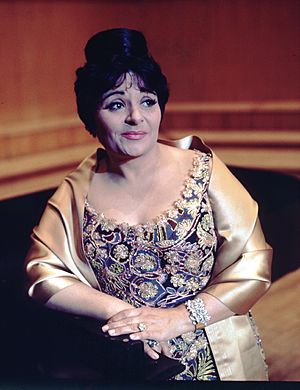Victoria de los Ángeles facts for kids

Victoria de los Ángeles (born November 1, 1923 – died January 15, 2005) was a famous Spanish opera singer. She was a lyric soprano, which means she had a beautiful, clear, and high singing voice. Her career really took off after World War II and she was one of the top singers from the mid-1950s to the mid-1960s.
Contents
Early Life and Studies
Victoria de los Ángeles was born in Barcelona, Spain. Her full name was Victoria de los Ángeles López García. Her father, Bernardo Lopez Gómez, worked as a caretaker at the University of Barcelona.
She started studying singing with Dolores Frau and guitar with Graciano Tarragó at the Barcelona Conservatory. She was a very fast learner! She finished her studies in just three years, graduating in 1941 when she was 18 years old.
Her Amazing Music Career
Victoria de los Ángeles began her opera journey in 1941 while still a student. She sang the role of Mimì in the opera La bohème at the Liceu theater. After that, she went back to her studies for a bit. In 1945, she returned to the Liceu for her first professional role as the Countess in The Marriage of Figaro.
Winning Awards and Early Performances
In 1947, she won first prize at the Geneva International Music Competition. This helped her become known around the world. The next year, she sang in London with the BBC. She performed in the opera La vida breve by Manuel de Falla. Many of her early recordings featured her guitar teachers, Graciano Tarragó and his daughter, Renata Tarragó.
Victoria de los Ángeles also sang a lot of "florid music" when she was younger. This means music with many fast notes and fancy decorations. Later, she performed less in operas but continued to give concerts. She sang many French, German, and Spanish songs, even some with Nahuatl words by Mexican composer Salvador Moreno Manzano. She kept performing these concerts into the 1990s.
Singing Around the World
In 1949, she sang in Paris at the Opera Garnier for the first time. The next year, 1950, was a big one! She made her debut at the Salzburg Festival and at the Royal Opera House in London, again as Mimì. She also had her first concert in the United States at Carnegie Hall in New York.
In March 1951, she sang at the famous Metropolitan Opera in New York as Marguérite. She performed with this company for ten years! In 1952, she became a favorite in Buenos Aires, Argentina, singing the main role in Madama Butterfly. She visited Buenos Aires many times until 1979. She also sang at La Scala in Milan from 1950 to 1956, and at the Vienna State Opera in 1957.
Focusing on Concerts
After singing at the Bayreuth Festival in 1961, she mostly focused on giving concerts. However, for the next twenty years, she still appeared sometimes in one of her favorite opera roles: Bizet's Carmen. She was one of the first Spanish singers to record the entire Carmen opera. She did this in 1958 with conductor Sir Thomas Beecham.
Even though Carmen fit her voice well, she also sang other important soprano roles. Some of these included Donna Anna, Manon, Nedda, Desdemona, Cio-Cio-San, Mimi, Violetta, and Mélisande.
Victoria de los Ángeles often performed song concerts with pianists Gerald Moore and Geoffrey Parsons. Sometimes, she even sang with other famous singers like Elisabeth Schwarzkopf and Dietrich Fischer-Dieskau. Her concerts of Spanish songs with her close friend, pianist Alicia de Larrocha, were also very popular. She even sang at the Barcelona Olympic Games in 1992, when she was 68 years old!
Recordings and Recognition
She made many recordings that people loved. These included La vida breve, La bohème, Pagliacci, and Madama Butterfly. In the last three, she sang with the amazing tenor Jussi Björling. She really admired his talent. She once said that even with all the recording technology, none of Björling's recordings truly captured how beautiful his voice was in person.
In 1994, the government of France honored her by naming her a Chevalier of the Légion d'honneur, a very high award.
Personal Life and Later Years
Victoria de los Ángeles married Enrique Magrina in 1948. Sadly, he and one of their two sons passed away before her. She died in her hometown of Barcelona on January 15, 2005, at the age of 81. She had been in the hospital for a lung infection. She was buried in the Montjuïc Cemetery in Barcelona.
In her home region of Catalonia, after the time of Francisco Franco, she often used the Catalan version of her name, Victòria dels Àngels.
How She is Remembered
Many people praised Victoria de los Ángeles's voice. The Times newspaper in the UK said she was "among the finest singers of the second half of the 20th century." Music expert Elizabeth Forbes wrote that it was "impossible to imagine a more purely beautiful voice" than hers. In 2007, BBC Music Magazine ranked her as the third best soprano of all time, after Maria Callas and Dame Joan Sutherland.
A music school in Sant Cugat del Vallès, Spain, is named after her (Escola Municipal de Música Victòria dels Àngels). There is also a plaza named after her there. Several other towns in Catalonia have streets named in her honor.
Some of Her Recordings
Victoria de los Ángeles made many recordings throughout her career. Here are a few examples:
- 1952: La Vida Breve by Manuel de Falla
- 1953: Faust by Charles Gounod
- 1954: Madama Butterfly by Giacomo Puccini
- 1955: Les nuits d'été by Hector Berlioz
- 1956: La bohème by Giacomo Puccini
- 1959: Carmen by Georges Bizet
- 1965: La Vida Breve (another recording)
- 1990: Chants d'Auvergne by Joseph Canteloube
- 1992: Traditional Catalan Songs
See also
In Spanish: Victoria de los Ángeles para niños

